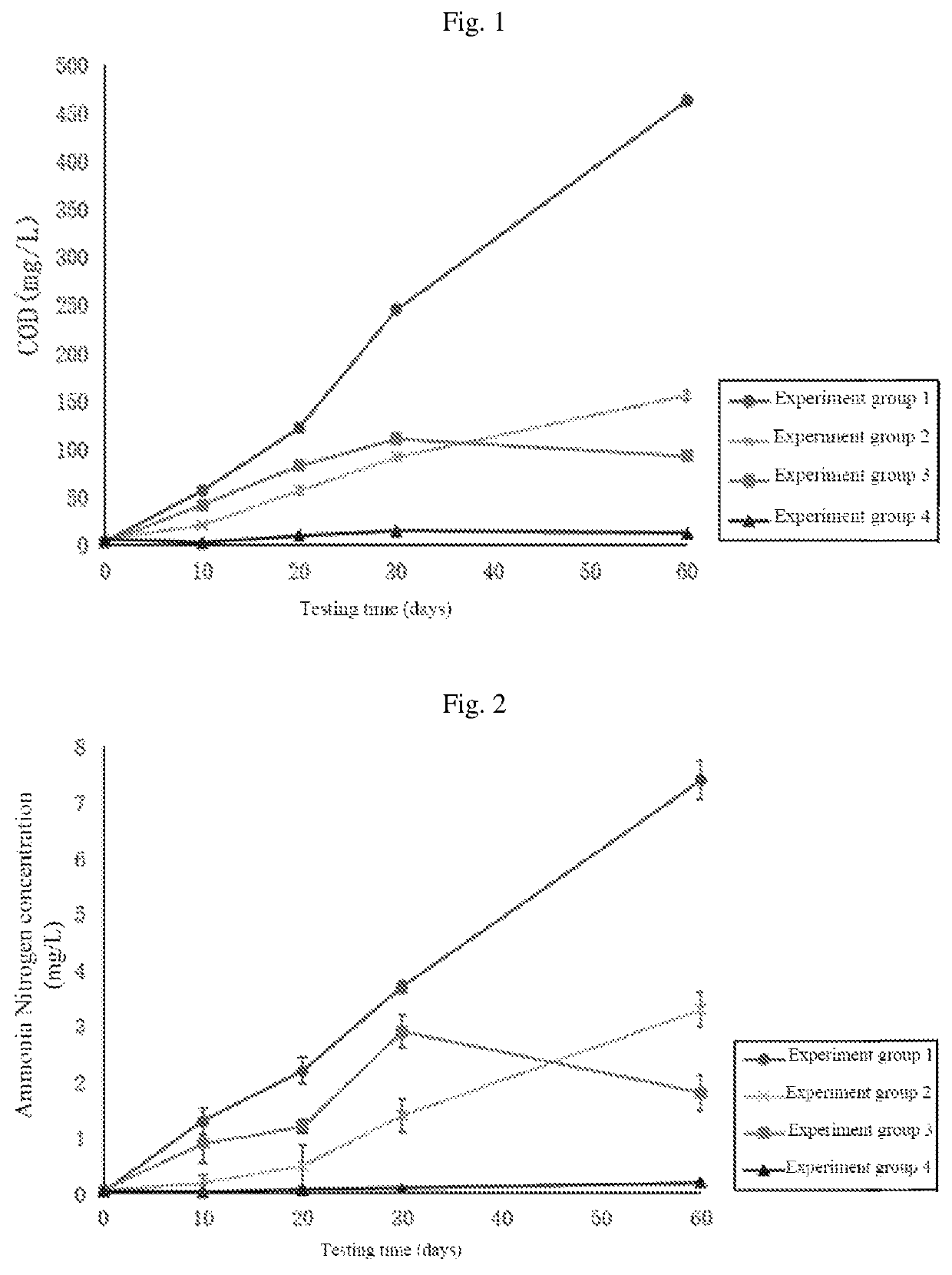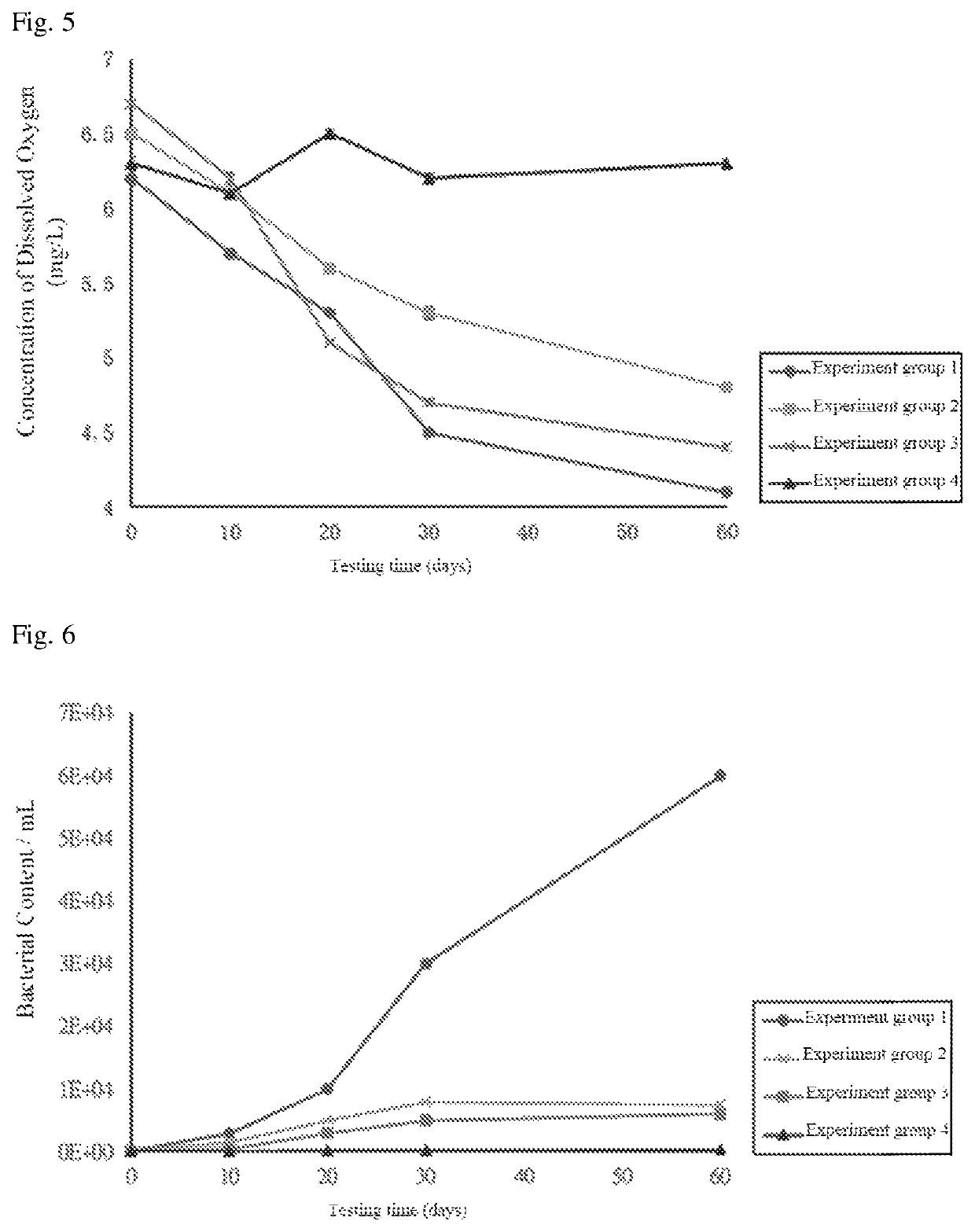Filter material for culture system, and preparation method and use thereof
a filter material and culture technology, applied in the direction of electrochemical treatment of water/sewage, filtration separation, separation processes, etc., can solve the problems of affecting the health of organisms, reducing ornamental value, water pollution, etc., to reduce the consumption of hydroxyl radicals, reduce the retention time of wastewater in pores, and increase the specific surface area of the filter material
- Summary
- Abstract
- Description
- Claims
- Application Information
AI Technical Summary
Benefits of technology
Problems solved by technology
Method used
Image
Examples
example 1
[0078]A filter material for a culture system consisted of the following components (% by mass):
[0079]50% of an anode material, 30% of a cathode material, 8% of a binder, 5% of a catalyst, and 7% of an acidifying agent, wherein
[0080]the anode material: a mixture of iron and aluminum in a mass ratio of 1:0.8;
[0081]the cathode material: carbon;
[0082]the binder: a mixture of clay and sodium silicate in a mass ratio of 1:1;
[0083]the catalyst: a mixture of calcium peroxide and calcium carbonate in a mass ratio of 1:0.5;
[0084]the acidifying agent: a mixture of phosphoric acid, lactic acid and formic acid in a mass ratio of 1:0.5:0.5, this mixture was then mixed well with silicon dioxide and embedded with a sustained-release material to give a mixture, wherein the mass ratio of the acidifying agent, silicon dioxide and the sustained-release material was 1:0.5:0.8, and the sustained-release material was a mixture of stearic acid and magnesium stearate in a mass ratio of 1:1.
[0085]This filter...
example 2
[0087]A filter material for a culture system consisted of the following components (% by mass):
[0088]45% of an anode material, 35% of a cathode material, 5% of a binder, 10% of a catalyst, and 5% of an acidifying agent, wherein
[0089]the anode material: a mixture of iron, zinc and copper in a mass ratio of 1:0.3:0.15;
[0090]the cathode material: a mixture of carbon and manganese in a mass ratio of 1:0.3;
[0091]the binder: a mixture of clay, sodium silicate and polyvinyl alcohol in a mass ratio of 1:1:1;
[0092]the catalyst: calcium oxide,
[0093]the acidifying agent: a mixture of phosphoric acid and malic acid in a mass ratio of 1:1, this mixture was then mixed well with silicon dioxide and embedded with a sustained-release material to give a mixture, wherein the mass ratio of the acidifying agent, silicon dioxide and the sustained-release material was 1:0.3:0.6, and the sustained-release material was a mixture of maltodextrin and modified starch in a mass ratio of 1:1.
[0094]This filter ma...
example 3
[0096]A filter material for a culture system consisted of the following components (% by mass):
[0097]45% of an anode material, 35% of a cathode material, 5% of a binder, 10% of a catalyst, and 5% of an acidifying agent, wherein
[0098]the anode material: a mixture of iron, aluminum and zinc in a mass ratio of 1:0.4:0.2;
[0099]the cathode material: a mixture of carbon and manganese in a mass ratio of 1:0.2;
[0100]the binder: a mixture of clay and sodium carboxymethylcellulose in a mass ratio of 1:1;
[0101]the catalyst: a mixture of calcium peroxide and calcium carbonate in a mass ratio of 1:1;
[0102]the acidifying agent: phosphoric acid, it was then mixed well with silicon dioxide and embedded with a sustained-release material, wherein the mass ratio of the acidifying agent, silicon dioxide and the sustained-release material was 1:0.4:0.6, and the sustained-release material was a mixture of shellac, magnesium stearate and sodium carboxymethylcellulose in a mass ratio of 1:1:1.
[0103]This fi...
PUM
| Property | Measurement | Unit |
|---|---|---|
| electrode potential | aaaaa | aaaaa |
| time | aaaaa | aaaaa |
| length | aaaaa | aaaaa |
Abstract
Description
Claims
Application Information
 Login to View More
Login to View More - R&D
- Intellectual Property
- Life Sciences
- Materials
- Tech Scout
- Unparalleled Data Quality
- Higher Quality Content
- 60% Fewer Hallucinations
Browse by: Latest US Patents, China's latest patents, Technical Efficacy Thesaurus, Application Domain, Technology Topic, Popular Technical Reports.
© 2025 PatSnap. All rights reserved.Legal|Privacy policy|Modern Slavery Act Transparency Statement|Sitemap|About US| Contact US: help@patsnap.com



